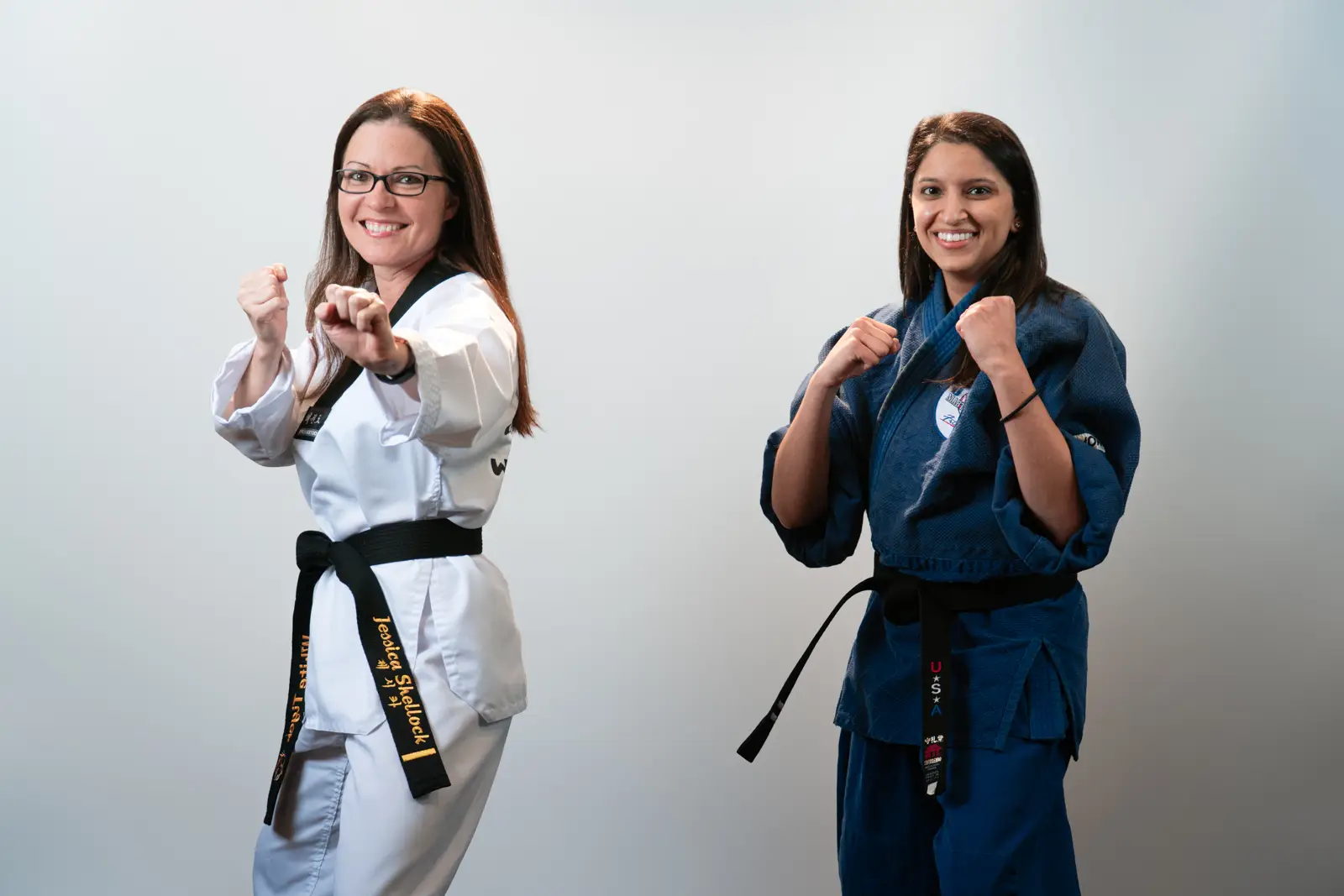Some may argue on the surface they don’t have much in common, as martial arts are typically used for self-defense or attack, whereas medicine is used to heal and care for patients. But, when talking with Dr. Jessica Shellock, Orthopedic Spine Surgeon and Dr. Sheena Bhuva, Physiatrist, about their life in medicine and the martial arts there is much more in common between the practices.

Origins of Martial Arts
Martial Arts has evolved over the years with different types from all over the world.
Karate is one of the most popular martial arts, finding it roots in Japan focused on self-defense and self-discipline.
Taekwondo is said trace its roots to the oldest martial art ‘Taek Kyon’, dating back to 50 B.C. in Korea. Modern Taekwondo was heavily influenced by Karate, after the Japanese invasion of Korea in World War I through the end of World War II.
Krav Maga is an Israeli martial art, used by Israel’s military and many law enforcement agencies for real world close combat scenarios.
Jiujitsu is traced back to Buddhist monks in India, but was transformed into the modern form of jujitsu used by the Japanese Samurai where discipline is highly valued.
Brazilian Jiujitsu on the other hand was developed in the 1920s, is used more for sport, focusing more on grappling, and is essential to MMA fighting styles.
Kung Fu is an amalgamation of hundreds of Chinese martial arts incorporating old Chinese philosophies used to teach a system of ethics in addition to physical and mental training.
Becoming a Black Belt
Most modern martial arts use a belt system of advancement and rank, most use the Black Belt as the highest rank. Dr. Jessica Shellock recently earned her Black Belt in Taekwondo along with her son.
“It started a little over 3 years ago, as something to do with my son” said Dr. Shellock, “It was something I saw as a bucket list accomplishment for myself, and something to build confidence, character, and respect as well as self-defense for my son.”
Dr. Sheena Bhuva on the other hand earned her black belt in American Freestyle Martial Arts as a teenager. Both Dr. Shellock and Dr. Bhuva said it took about 3.5 years to earn their 1st degree black belt, and Dr. Bhuva went on to earn her 2nd degree black belt two years later.
“I practiced American Freestyle Martial Arts also known as USA Martial Arts, which is a combination of Jiujitsu, Karate, and Taekwondo,” said Dr. Bhuva “I started when I was ten, when my mom had the foresight to get me started in martial arts to instill confidence and other lifelong skills.”
Perseverance to Earn a Black Belt and to Practice Spine Care
There is no doubt, pursuing your black belt and becoming a doctor both take perseverance. According to Japanesemartialartscenter.com only 3-5% of people who start martial arts end up earning their black belt. Being successful in the martial arts requires dedication, discipline, physical and mental strength. The same is true about earning a medical degree, completing residency, and finishing a specialized fellowship program. In a study done by the AAMC (Association of American Medical Colleges) less than 15% of students aspiring to become doctors will succeed. According to the American Medical Association, only 3.23% or residents choose to go into Orthopedics, and according to the AAOS report “Orthopaedic Practice in the U.S. 2008” only 11% of Orthopedists practice adult spine surgery. While Dr. Jessica Shellock chose this route to become an Orthopedic Spine Surgeon, Dr. Sheena Bhuva chose to become a Physiatrist. In the study done by the American Medical Association only 0.17% of residents succeed in obtaining their Physical Medicine and Rehabilitation license.
While earning their black belts only took 3 years, becoming a spine care specialist takes 9-10 years of intensive studies. Typically, each spine specialist finishes 4 years of college, 4 years of medical school, 5 years of residency, and at least 1 year of fellowship. When talking about the similarities of martial arts and medicine Dr. Shellock said, “when achieving my first-degree black belt, I can continue to learn and grow, the same way I continue to grow and learn as a surgeon. It instills in you that drive to become better and become more.”
Virtues in Martial Arts and Medicine
Most Martial Arts teach not only physical and mental training, but many teach valuable moral virtues to live by. “The main tenets of Taekwondo are respect, integrity, courtesy, perseverance; these are things that I hope we all strive to represent as human beings toward each other, and it has helped reinforce these traits within me when interacting with people and patients on a day to day basis,” said Dr. Shellock.
“Some of my fondest memories of my time in martial arts was at the end of class reciting those words on the wall: respect, integrity, modesty, perseverance,” said Dr. Bhuva, “as I got older, getting closer to earning my black belt and really understanding what those words mean I am incorporating them into my life.”
These virtues are similar to those we expect our doctors and staff to hold to at Texas Back Institute. S.P.I.N.E. is the acronym doctors and employees have chosen to represent Texas Back Institute’s standards of performance.
- Superior Service
- Positive Attitude
- Innovative Care
- Nurturing Spirit
- Ethical Behavior
If you or a loved one is dealing with neck or back pain, contact the specialists at Texas Back Institute for a consultation and tailored treatment plan.





